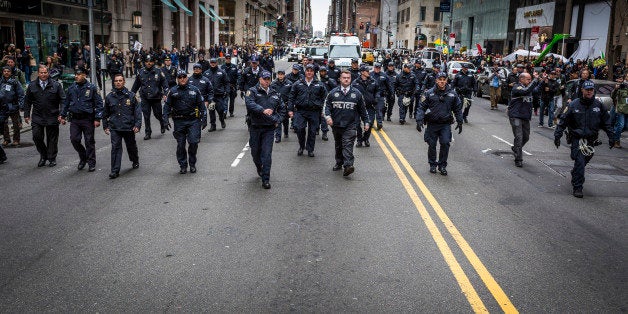
On a sunny spring day in May 1970 more than a thousand young peace activists gathered to march from Wall Street to Federal Hall in Manhattan. Four days earlier, 13 Kent State students had been shot -- four of them fatally -- by the Ohio National Guard during a protest against the recent American invasion of Cambodia. New York City's liberal Republican Mayor John Lindsay (derisively called "the Mayor of Hanoi" by his conservative enemies) ordered flags in New York City to be flown at half-mast in memory of the slain students at Kent State.
As the Manhattan peace protesters made their way through the steel and concrete canyons to Federal Hall, 200 white, middle-aged, construction workers in hard hats and carrying American flags barred their way and chased the young hippies through the streets beating them with lead pipes and crowbars. Policemen stood by passively and watched. More than 70 protesters were injured, and 20 hospitalized. A few days later president Nixon met with the "Hard Hat Riot" members at the White House to turn a patriotic victory lap.
The class and cultural battle lines, which began forming during the Civil Rights movement in the early '60s, were now set in stone.
Hard Hat Riot 1970, meet Donald Trump 2016. Trump's brand of xenophobia and nationalism has ignited rage on both sides of his security fence. For months, Trump's campaign rallies have been plagued with outbursts of anger and physical violence. In March, the campaign cancelled a Chicago event because so many protesters inside the arena rendered it a security risk. At a Trump event in Costa Mesa California on April 29, dozens of protesters blocked traffic, threw punches and overturned a police car. Police in full riot gear dispersed the crowd from mounted horseback. The next day, a cable news commentator compared the Costa Mesa melee to the Chicago Democratic convention in 1968 -- a bit of a stretch because Chicago '68 was much bigger and bloodier, but a reminder nonetheless of how the anger, violence of the late '60s haunts this year's presidential election.
Trump has openly fueled the fire: "I'd like to punch him in the face," he told one audience, referring to a man who had just disrupted his speech. "People come [to Trump campaign events] with tremendous passion and love for their country," Trump told CNN's Jake Tapper in an interview. "When they see what's going on in this country, they have anger that's unbelievable. They have anger. They love this country." Now that Trump is the inevitable Republican nominee the lessons of the '60s admonish us to brace for more civil unrest to come.
Nixon's Silent Majority (a term Trump has adopted), personified by the "patriotic," pro-war Hard Hats in New York, hated the free-love peaceniks of the youth culture. They stood on one side of an unbridgeable generation, political, and cultural gap in American society. Fury over the Vietnam War and the draft, which touched the lives of 27 million young men, mounted during that academic calendar year of 1969/1970, when 9,000 protests and 84 acts of arson and bombings erupted at schools, and two and a half million students shut down 700 colleges and universities. The Scranton Commission, appointed by president Nixon after Kent State, warned that the student strikes had imposed a "crisis as deep as the Civil War [and] if this crisis of understanding endures, the very survival of the nation will be threatened." The country was coming unhinged, and the popular term youthquake barely captured the destructive vibrations of this anti-establishment explosion. "If you didn't experience it back then," Nixon aide Stephen Bull told me, "you have no idea how close we were, as a country, to revolution."
The movement for social change in the '60s was an umbrella that encompassed the antiwar, anti-imperialist, socialist, civil rights, counterculture, feminist, gay rights, environmentalist, and native American rights movements. The young left was at war with the establishment represented by presidents LBJ and Nixon, the FBI, the Republican and Democratic parties, the military, large banks and corporations, and the cops.
The populist anger of the 2016 presidential campaign is not just confined to Donald Trump supporters. Bernie Sanders has captured a similar anti-establishment rage from the left. Both Sanders and Trump supporters are fighting the new "establishment," a modern international economy that has left the white working class behind and created a huge wage gap, while a disabled and ineffective Congress does nothing but fan the flames to get reelected. Trump blames immigrants, Sanders blames big banks, Citizen's United, and they both blame Congress and Hillary Clinton.
International trade deals like NAFTA and TPP have become a rallying cry -- the new Vietnam-lite. Sanders, a 74-year-old socialist ex-hippie from Vermont, has ignited the younger generation with energy and crowds worthy of the Vietnam era. Sanders and Trump have tapped a similar vein of revolutionary fervor -- what was then called "the Awakened generation" could describe Bernie's youthquake. Compromise is again a dirty word. Sanders hasn't encouraged physical violence, but he has successfully villainized big financial institutions and Hillary Clinton as the establishment, ironically "the Man." He lumps them together as members of the same corrupt corporate power structure that must hear his calls for real change.
If we are to learn anything from the lessons of the '60s, it is that movements matter -- and they are ignored at our peril. After the dust settled in the early 1980s, the verdict of the '60s could be boiled down to: cultural revolutionaries won, political revolutionaries lost. Americans inherited unprecedented levels of personal freedom, yet we still struggle with recidivist engagement in overseas wars. If harnessed, the populist energy of the 2016 election can perhaps fulfill some of the unfinished business of the '60s. But if ignored, the revolution that never fully exploded remains a very real existential threat to our democracy.
---
Clara Bingham is the author of WITNESS TO THE REVOLUTION: Radicals, Resisters, Vets, Hippies, and the Year America Lost Its Mind and Found Its Soul.”
